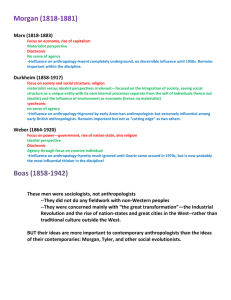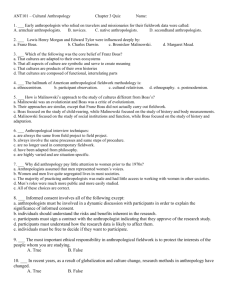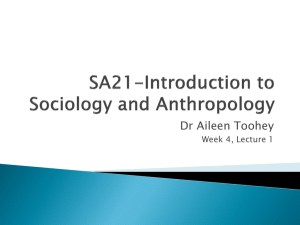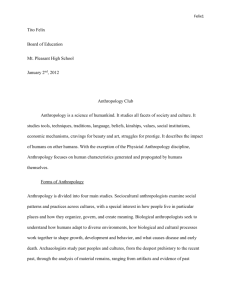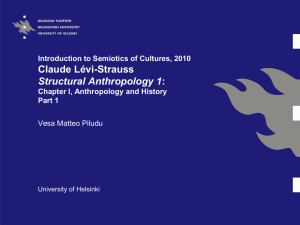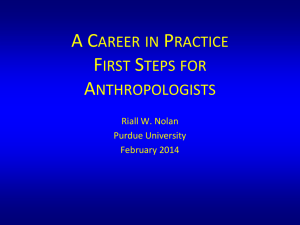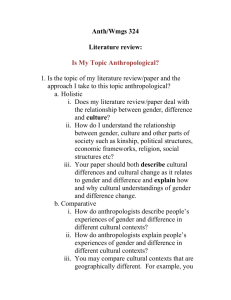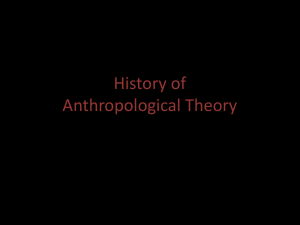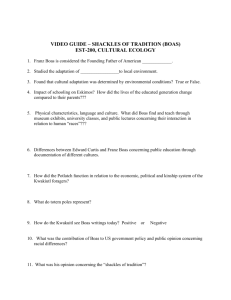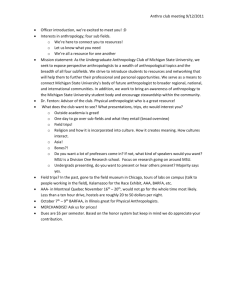Anthropological Theory Test Bank: Growth & Development
advertisement
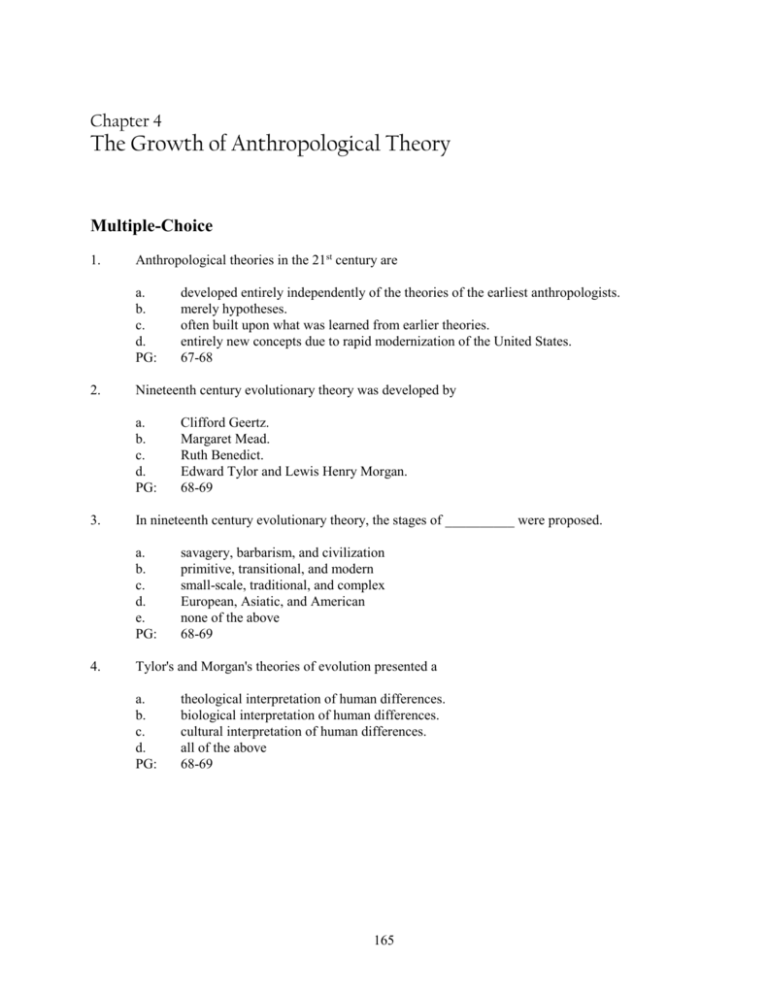
Chapter 4 The Growth of Anthropological Theory Multiple-Choice 1. Anthropological theories in the 21st century are a. b. c. d. PG: 2. Nineteenth century evolutionary theory was developed by a. b. c. d. PG: 3. Clifford Geertz. Margaret Mead. Ruth Benedict. Edward Tylor and Lewis Henry Morgan. 68-69 In nineteenth century evolutionary theory, the stages of __________ were proposed. a. b. c. d. e. PG: 4. developed entirely independently of the theories of the earliest anthropologists. merely hypotheses. often built upon what was learned from earlier theories. entirely new concepts due to rapid modernization of the United States. 67-68 savagery, barbarism, and civilization primitive, transitional, and modern small-scale, traditional, and complex European, Asiatic, and American none of the above 68-69 Tylor's and Morgan's theories of evolution presented a a. b. c. d. PG: theological interpretation of human differences. biological interpretation of human differences. cultural interpretation of human differences. all of the above 68-69 165 TEST BANK / CHAPTER 4 5. Morgan proposed that the three stages of savagery were associated with a. b. c. d. PG: 6. Diffusionism stresses how a. b. c. d. PG: 7. the principle of evolution as the major explanatory reason for cultural variability. different levels of cultural borrowing to explain cultural diversity. inductive methodology. a and c 69-70 The school of Diffusionism could not explain a. b. c. d. PG: 9. inventive Egyptians are. distinctive different cultures are. inventive Europeans are. uninventive people are. 69-70 The diffusionists concentrated on a. b. c. d. PG: 8. monumental architecture. food collecting. the domestication of plants and animals. a and c 68-69 why some traits diffused when others did not. what conditions bring about diffusion of a cultural item. what determines the rate of cultural diffusion. all of the above 69-70 Diffusionism and evolutionism had in common a. b. c. d. PG: the idea of a deductive approach. the idea of a single center for the invention of culture. the idea of a straight line of cultural evolution that was universal. the same explanation for cultural diversity. 70 166 CHAPTER 4 / TEST BANK 10. American historicism was developed by a. b. c. d. PG: 11. Franz Boas argued that the discipline of anthropology needed a. b. c. d. PG: 12. Ruth Benedict. Edward Tylor. Alfred Radcliffe-Brown. Marvin Harris. 71 Functionalist theory that focused on how cultures met the needs of individuals was developed by a. b. c. d. PG: 14. the careful collection of empirical data on as many specific cultures as possible. the development of complex theory as soon as possible. theory that clarified how contact with other people was the single most important factor in shaping any society's culture. theory that emphasized the environment as the single factor determining a culture. 70-71 Boas trained nearly the entire first generation of American anthropologists, including a. b. c. d. PG: 13. Melville J. Herskovits. Claude Lévi-Strauss. Ruth Behar. Franz Boas. 70-71 Claude Lévi-Strauss. Alfred Radcliffe-Brown. Bronislaw Malinowski. Franz Boas. 71-74 Nineteenth century evolutionary theory was developed by a. b. c. d. PG: Claude Lévi-Strauss. Franz Boas. Bronislaw Malinowski. Edward Tylor and Lewis Henry Morgan. 68 167 TEST BANK / CHAPTER 4 15. The two theorists (one in England and one in the U.S.) who gave the greatest importance to fieldwork were a. b. c. d. PG: 16. The functionalist concept of universal function means a. b. c. d. PG: 17. that every component of a culture has a function. that social structure is universal. that individual needs are universal. that culture is an integrated whole. 73 The notion of dysfunction was a. b. c. d. PG: 19. that every component of a culture has a function. that social structure is universal. that individual needs are universal. that culture is an integrated whole. 73 Functional unity means a. b. c. d. PG: 18. Tylor and Morgan. Boas and Morgan. Malinowski and Radcliffe-Brown. Boas and Malinowski. 71 proposed by Merton to refer to stress or imbalance in a cultural system. proposed by Radcliffe-Brown to refer to stress or imbalance in a cultural system. proposed by Merton to refer to unintended or unrecognized functions of culture. proposed by Radcliffe-Brown to refer to unintended or unrecognized functions of culture. 73-74 Psychological anthropology was developed a. b. c. d. PG: by psychologists rather than anthropologists. by anthropologists interested in the relationship between personality and employment. by students of Boas interested in the question of the relationship of personality and culture. by individuals with no interest in the impact of child-rearing on human societies. 74-76 168 CHAPTER 4 / TEST BANK 20. Leslie White and Julian Steward developed the theory of a. b. c. d. PG: 21. The Functionalists and the American Historicists were similar in that both a. b. c. d. PG: 22. c. d. PG: the relationship of ideology to environment. the relationship between the structure of the human brain and the development of technology. humans' use of technology to "capture energy." all of the above 76-77 French structuralism concentrates on a. b. c. d. PG: 24. encouraged direct fieldwork. were inductive rather than deductive. were associated with the 20th century. all of the above 71 Leslie White, in his theory, focused on the harnessing of energy and a. b. 23. ethnoscience. psychological anthropology. neoevolutionism. diffusionism. 76-77 human adaptation to the environment. level of technological achievement. the identification of mental structures that undergird social behavior. the political and economic structures of societies. 78 Ethnoscience, like French structuralism, a. b. c. d. PG: draws upon a linguistic model. seeks explanation in the human mind. views human behavior from a logical or rational perspective. all of the above 79 169 TEST BANK / CHAPTER 4 25. The primary aim of ethnoscience is to a. b. c. d. PG: 26. Most anthropologists today a. b. c. d. PG: 27. reported on the divorce rate of that society and compared it to the United States. tried to determine if the strains of adolescence are universal. found that Samoan youth are equally stressed as youth of the United States. found that Derek Freeman had not portrayed Samoan adolescents accurately. 75 Margaret Mead, in her research in Samoa, a. b. c. d. PG: 29. utilize evolutionary theory. utilize neoevolutionary theory. do not tie themselves to a single theoretical orientation. utilize ethnoscience theory. 85 In Coming of Age in Samoa, Margaret Mead's first book a. b. c. d. PG: 28. understand a culture from the point of view of the people themselves. identify the universal rules found in all the societies of the world. describe a culture in terms of the categories of the ethnographer. do a complete ethnoscientific study of every aspect of a culture. 79 concluded that the emotional turbulence of adolescents in the United States is culturally rather than biologically based. has definitely been proved inaccurate due to poor quality fieldwork. has definitely been proved inaccurate in spite of the superior quality of her fieldwork. demonstrated the importance of genes rather than cultural conditioning. 75 Leslie White argued that the driving force of cultural evolution was a. b. c. d. PG: the complexity of language. political complexity. the amount of energy harnessed per capita. ideological progress. 76 170 CHAPTER 4 / TEST BANK 30. Lévi-Strauss' approach emphasizes the importance of a. b. c. d. PG: 31. The interpretive approach a. b. c. d. PG: 32. learn about the ecological need for conserving trees. clear cut trees to open more land for agriculture. own the trees they grow. grow trees rather than food crops. 72-73 The theory that people are inherently uninventive and prefer to borrow the inventions of other cultures, rather than inventing them for themselves, is a tenet of which of the following schools of thought? a. b. c. d. PG: 34. sensitizes anthropologists to their own views and values. is wedded to the etic approach. sensitizes anthropologists to the views and values of the informant. a and c 84 Murray, in his USAID reforestation project in Haiti, recommended that the local farmers a. b. c. d. PG: 33. certain codes, programmed into the human mind, which make it impossible for humans to learn more than one culture. certain codes, programmed into the human mind, which are responsible for shaping cultures. cultural traits which universally have the same function. all of the above 78 Evolutionists Diffusionists Functionalists Psychological Anthropologists 69-70 Postmodernists emphasize a. b. c. d. PG: solitary research by one ethnographer. the rejection of generalizing and developing predictable theories. their close relation to biology. the etic approach. 83-85 171 TEST BANK / CHAPTER 4 35. Cultural materialism a. is wedded to the emic approach. b. emphasizes the etic approach. c. avoids participant-observation. d. was created by Ruth Benedict. PG: 82-83 36. Cultural materialism a. b. c. d. PG: 37. Postmodern anthropology a. b. c. d. PG: 38. holds that material conditions determine human thoughts and behavior. assumes the viewpoint of the native informant. de-emphasizes the role of ideas and values in determining the conditions of social life. a and c 82-83 is similar to the Cultural Materialist School. is wedded to the etic point of view. should be written from several perspectives, that of the anthropologist and that of the local people. aims at the construction of laws and generalizations. 83-85 One of the primary advocates for the theory of French structuralism is a. b. c. d. ANS: PG: Franz Boas. Ruth Benedict. Claude Lévi-Strauss. Marvin Harris. C 78 39. Which of the following anthropologists is not associated with the school of Feminist Anthropology which emerged in the 1960s and 1970s?: a. b. c. d. ANS: PG: 40. Annette Weiner Ruth Benedict Micaela di Leonardo Sherry Ortner B 80-82 Which statement best describes Feminist Anthropology?: a. It takes an objective/scientific approach to the study of society 172 CHAPTER 4 / TEST BANK b. c. d. PG: Gender should not be considered as a major variable influencing cultural behavior. It strongly embraces a value-free orientation. It calls for the long-overdue correction to male bias in traditional ethnographies. 80-82 True-False 1. Anthropological theory attempts to explain the great cultural diversity in the world. PG: 67 2. Tylor and Morgan, as nineteenth-century evolutionists, based their theories on fragmentary data. PG: 68-69 3. The British diffusionists maintained that all cultural features, wherever they may be found, had their origins in Britain. PG: 69-70 4. Boas called for a moratorium on theorizing. PG: 70-71 5. The study by Gibson and Weisner of the New Hope Antipoverty Program in Milwaukee, WI, was significant because it illustrates how theory can be useful to applied anthropology. PG: 80-81 6. Some 50 years after Margaret Mead published Coming of Age in Samoa, the book’s findings were challenged by Derek Freeman. PG: 75-76 7. In the 21st century there are more women than men completing PhDs in anthropology. PG: 71 8. Lévi-Strauss' theory maintains that the human mind thinks in binary oppositions. PG: 78 9. Ethnoscience attempts to describe a culture as it is perceived and categorized by the ethnographer. PG: 79 10. Postmodernists emphasize that ethnographies should be written from several voices. PG: 83-85 Short Answer 1. Define theory. PG: 67 173 TEST BANK / CHAPTER 4 2. What is the basic premise of the theory of evolutionism? PG: 68-69 3. What seven stages did Morgan define in evolutionary theory? PG: 68 4. Which anthropologist trained virtually the entire first generation of American anthropologists? PG: 71 5. In addition to performing the function of distributing goods within the society, what other areas of Trobriand culture are related to the kula ring? PG: 72 6. What are the two fundamental principles upon which the functionalist approach is based? PG: 73 7. What was Margaret Mead attempting to demonstrate in her research among the Arapesh, Tchambuli, and Mundugumor of New Guinea? PG: 75 8. To which school of anthropological theory does this formula relate - C = E x T? PG: 76 9. What is the task of an ethnoscientist? PG: 79 10. What three aspects do cultural materialists consider the most important parts of cultural systems? PG: 82 Essay 1. How is Margaret Mead's portrayal of Samoa different from that of Derek Freeman's? What has anthropology learned from this controversy? Is either anthropologist right or wrong? 2. How are the preordained evolutionary stages of Tylor's and Morgan's theories of cultural evolution ethnocentric? What effect did limited empirical data on non-Western societies have on the development of this theory? 3. What are the most important contributions of Boas' American historicism approach? Why was ethnographic fieldwork important to him? Why did he want women trained as anthropologists? 4. Select any two of the following schools of anthropology and discuss its assumptions, methods, and theories. Who were its leading proponents and opponents? Discuss in a critical way the schools’ major contributions and shortcomings. 174 CHAPTER 4 / TEST BANK Evolutionists American Historicists 5. Diffusionists Functionalists What is cultural materialism? How does its position and methodology differ from the postmodern approach? 175
